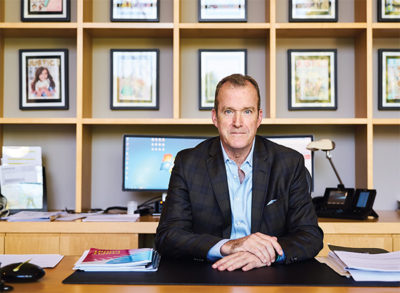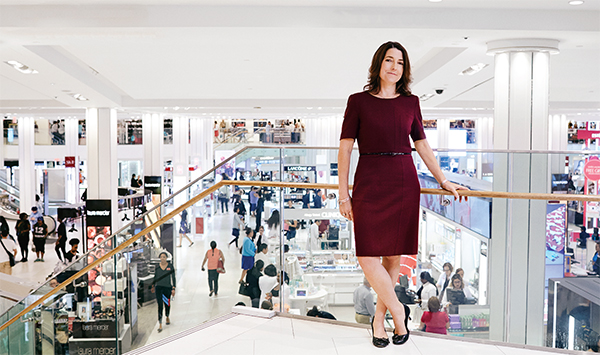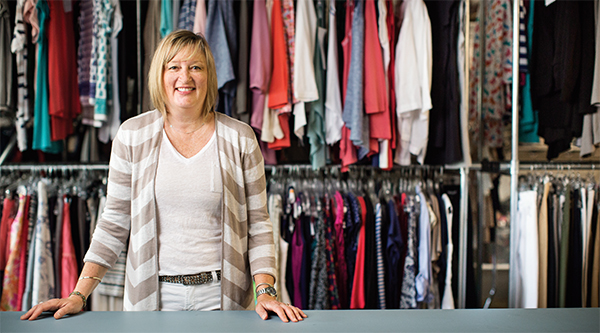
Brian Lynch ’79, president and CEO of Justice, a specialty retailer of young girls apparel and lifestyle products
In his first job after graduating from Babson in 1979, Brian Lynch worked for a clothing store known as The Lodge at Harvard Square. Each time Lynch made a sale, he would pull the tags off the garments. The tags then were collected, boxed up, and sent to an off-site company that calculated such stats as sell-through rates. Nearly a week later, the results would arrive in the mail.
“The timing of the information was frighteningly slow,” recalls Lynch, a 36-year veteran of clothing retailers, including Gap and Ann Inc. Currently, he’s president and CEO of Justice, a specialty retailer of young girls (ages 7 to 14) apparel and lifestyle products with more than 950 stores in the United States and 17 countries. “Today, everything’s instantaneous and complete and comprehensive.”
Lynch receives interim day readings with such information as foot traffic, the number of items in each purchase, the cost of each purchase, and the margins on each product.
“I know where we are during the day in all 950 stores,” he says. “It’s just a whole different ballgame.”
It’s an Omnichannel World
Monumental shifts have been going on in retail, say Babson alumni working in the industry. Changing the way retailers approach business are the explosion of digital commerce and the emergence of the omnichannel model, the latter of which acknowledges that customers are just as likely to shop on a laptop in their kitchen or from their phones as they are to drive to a store on a Saturday afternoon.
“Omnichannel has been revolutionary for the industry,” says Justin MacFarlane ’94, chief strategy, analytics, and innovation officer for Macy’s, the iconic department store. For more than a decade, MacFarlane was a management consultant for apparel manufacturers and retailers, and then he worked for Ann Inc. before joining Macy’s. “The industry had operated in a very linear way for a hundred years, and almost overnight we changed all that.”
Gone are the days when customer service meant simply staffing the store with responsive sales associates or hiring friendly, efficient people to answer phones at a catalog call center. Those elements are still important, say alumni, but retailers have had to revamp their businesses significantly to accommodate digital devices.
At Justice, Lynch and his team are focused on finding new ways to blend the digital and store experiences to make them seamless. For example, everything sold in Justice stores is available online, but the retailer also offers additional inventory as web-only products. So during the back-to-school shopping season this past summer, Justice rolled out an orderin- store option. Sales associates and store signs alert customers to the online products, viewable on their phones or an in-store computer. Customers then can pay for goods at the store register and arrange for them to be shipped home. “In the omni world, if you go into the store, you should be able to purchase any product that’s online,” Lynch says.
Many omnichannel retailers also provide the option of ordering products online and picking them up at a nearby store, notes Eileen Rizzo, MBA’97, senior vice president for omnichannel process and systems at Macy’s. This option appeals to customers who want to avoid shipping costs, prefer to pay cash, like to try on clothes before they buy, or just want their items fast. “There’s the immediacy of it,” Rizzo says. “If I’m browsing online at 9 a.m. and I want to wear it tonight, that’s really convenient.”
A 20-year retail veteran, Rizzo has worked as an industry consultant, as well as for Joan & David (a now-defunct shoe company) and J.C. Penney. She remembers when Amazon jump-started e-commerce in the 1990s. Retail companies wanted in on the game but built their dot-com businesses as separate entities, Rizzo says. Given that in-store and online customers were often the same people, that separation became problematic. Macy’s shifted its strategy around 2010, devoting resources to a blended, omnichannel approach. Today, while Macy’s has announced a recent spate of store closings, it is among the top five online retailers in the country, according to a 2016 Women’s Wear Daily ranking.
The Cost of Remaining Competitive
The transition to omnichannel has been expensive, alumni note, requiring major investments in infrastructure, such as building facilities to handle distribution. The services that customers have come to expect, including fast and low-cost (or free) shipping, increase costs for the retailer as well. “We’re constantly playing with and testing out the right level of inventory and where you put that inventory to be closest to the customer so we can reduce the cost of getting it to them,” Rizzo says.

Photo: Chris Langer
Brian Lynch of Justice
Retailers also need to stay ahead of the so-called “digital natives,” the younger generation who grew up using digital devices and balk at buggy apps or nonintuitive navigation. Mobile is “a big focus of what we’re doing today,” says Lynch of Justice. “The content must be native to these devices, so that the screenshot looks good, it fits on the phones people have, and is easily readable and accessible.”
Christopher Disa, MBA’11, director of global merchandising for women at Gap, says Gap customers in China didn’t really use desktop computers for e-commerce, but they recently went “from 0 to 60” in adopting mobile phones for making purchases. He notes that retailers are working to ensure customers get what they need in China and elsewhere, even when they’re using a small, hand-held screen.
Garnet Hill, a mainly mail-order retailer that specializes in women and kids fashion, as well as home products, receives roughly 86 percent of its sales transactions via the web and mobile devices, says Sandi Summerson, MBA’11, senior vice president and general merchandise manager. The other 14 percent of sales comes from phone orders and retail locations, including Garnet Hill’s outlet at its corporate headquarters in Franconia, New Hampshire. But the driver behind most of the company’s sales, even those coming from the web, is its deluxe catalogs, which feature Zen still-life covers and lavish photography. “We want to create something beautiful that the customer can read like a book,” Summerson says. So the company mails an estimated 40 million catalogs to customers each year, a significant investment.
Even in the digital age, catalogs remain an important tool for many companies, Summerson says. An 18-year veteran of L.L.Bean, where she led the women, kids, and home divisions, Summerson moved to the Sundance Catalog in Utah before she was hired by Garnet Hill nearly two years ago. She notes that in the early 2000s, multiple retailers, including Lands’ End, made the strategic decision to scale back their catalogs to cut costs, assuming customers would find the company online. But sales dropped significantly, forcing them to bring back the catalogs.
The Power of Analytics
Figuring out who customers are and what they prefer, such as a fondness for perusing catalogs, always has been pivotal to making smart strategic decisions. Today, however, alumni say the explosion of data available about customers and their purchasing habits has transformed strategy. Retailers know not only what clothes customers buy, but also such specifics as the brands they prefer, if they’re switching loyalty to other brands, and which price points and markdowns prompt them to buy. “This has been a big change over the last 10 years,” says MacFarlane of Macy’s. His team includes doctorate-level data scientists who analyze the reams of information now available about customers and their behavior. “These scientists are really helping us understand the power of our data and are unearthing pockets of competitive advantage.”
Summerson says that Garnet Hill has similarly detailed data about its customers. Retailers also can garner customer information through loyalty programs and private label credit cards, including how many times a year a customer makes a purchase. Summerson offers the example of kids clothing and backpacks, products she worked with in the past at L.L.Bean and now at Garnet Hill. “We have a huge backpack business at back-to-school time,” she says. “Many of these buyers purchase only the backpack, and nothing else.” Adding those customers to the catalog mailing list didn’t pay off. “Once we were able to analyze this data and target more valuable buyers, our mailing became much more productive,” she says.

Photo: Winnie Au
Eileen Rizzo, MBA’97, senior vice president for omnichannel process and systems at Macy’s
Rizzo of Macy’s adds that many retailers supplement in-house data with stats from The NPD Group, a market research firm that collects information about other companies’ customer transactions. “It’s a way of knowing what customers are doing in your competitive set so you can identify the opportunities to improve your business, and where you’re getting beat by your competition,” she says.
Retailers also are combining analytics with new technologies, hoping they can tempt customers to make purchases. Rizzo and her team currently are working to place radio-frequency beacons in stores to scan for shoppers with the Macy’s app on their phones. The company then can identify the shopper and know her history, including the fact that she was looking at a particular brand of shoes on its app the previous week. “Say she just walked into the store and happens to be in the shoe department,” Rizzo says. “I’m going to send her phone a 20 percent-off coupon good for the next hour on a pair of shoes.” Research shows that millennial customers respond especially well to this type of personalization, she says.
While the advantages of analyzing trends in customer data are clear, Disa of Gap believes it’s important not to be chained to the numbers and to supplement data with information gathered through simple observations. Disa, whose experience includes stints with Talbots and Puma, says he has taken his team on field trips to high schools at dismissal time to see what kids are wearing, and visited competitors’ stores to see how their assortment compared to his company’s. This kind of information gathering can inspire surprises that customers love, he says. “If it was only analytical, then it would be automated in a sense,” Disa says. “You can’t just look at numbers.”
MacFarlane agrees. Analytics provide valuable insights, but that data must be combined with knowledge that comes from experienced, savvy retail buyers. “It has to be blended,” says MacFarlane, “with merchants working together with the data scientists.”
What Customers Want
The central question that strategists use all this data to answer remains: What does the customer want? Lynch, who joined Justice a little more than a year ago, notes that the company has been in the midst of a turnaround. Part of that process was learning that the pricing structure was not working for its customers. Lynch’s team conducted extensive market research, including surveys and focus groups, and found that mothers, who typically get the final say in how much money will be spent, were turned off by Justice’s prices. “We had a lot of complicated promotions,” says Lynch, “and our initial tickets placed us as being the most expensive retailer in the category.”
Ultimately, the company arrived at new, more competitive prices, identifying some core products as “style buys” that never go on sale, while placing other items on sale periodically, but less often than before. “All of it has worked very, very well,” Lynch says.
Macy’s also is simplifying its price structure, rethinking its approach to markdowns and coupons. “Customers tell us that our pricing can be confusing,” MacFarlane says. “We’re working to alleviate that pain point for sure.”
At the same time, trends suggest that shoppers are hungry for deals, Rizzo says. She points to the increasing popularity of off-price retailers—T.J. Maxx, Marshalls, Burlington Coat Factory—where garments are a season or two behind and sell for lower prices. In response, Macy’s launched Backstage, its own off-price stores.
The emergence of “fast fashion,” made popular by retailers such as Zara and H&M, which produce new products swiftly and cheaply, also puts pressure on retailers to respond to trends more quickly. Social media, especially visual apps such as Instagram, make it easy for customers to see what people are wearing around the world and immediately seek similar styles. Most retailers typically need up to nine months to get products from design to the customer’s cart, Rizzo notes, but Spanish company Zara can get new designs to stores in a matter of weeks, in part by designing, manufacturing, and distributing from facilities located close together in Europe.
To compete with this fast pace, other retailers are developing tools that streamline the process of planning, designing, and manufacturing as well. “Fast fashion has forced us, in a good way, to become more agile from a supply chain standpoint so that we can provide the freshness and fashionable products that people are expecting,” MacFarlane says. New items in Inc. and Style&Co., two of Macy’s private brands, now reach stores in as little as four months, Rizzo adds.
Soon after Summerson arrived at Garnet Hill, the company introduced an integrated calendar tool that allows staff members to see how their decisions will impact others across the organization. For example, because the company offers certain core products every season, it can work with vendors to start the manufacturing process early, taking advantage of factory downtimes to get better pricing and, thus, wider margins. “If we’re behind in our design cycles and haven’t solidified our colors and silhouettes and miss our deadline to take advantage of our production cycle, we negatively impact our margins,” she says.
This system also helps ensure that the company stocks what customers want. The tool is used in weekly meetings, when merchandising, inventory, and supply chain teams meet to review business of the previous week and compare it with sales forecasts. “We discuss high-supply and low-supply inventory and areas of risk, along with suggested strategies to mitigate impact across the organization,” Summerson explains.
Inspiring Loyalty
The key to staying relevant in this ever-evolving environment, say alumni, is producing products that people can’t get elsewhere, maintaining direct relationships with customers, and inspiring loyalty. “It still cycles back to the customer and what unreplicable experience, service, or product you can offer that separates you from your competitors and makes you the go-to place,” Lynch says.
Summerson admires Urban Outfitters, a retailer that she believes has managed to stay relevant even though its customers age out of its demographic after just a few years. Urban Outfitters acquired the majority of The Vetri Family group of restaurants, including the chain Pizzeria Vetri, in 2015. Plans for the acquisition include opening Pizzeria Vetri locations next to Urban Outfitters and sister stores Anthropologie and Free People in malls, creating what the industry dubs brand clusters. “Brands are seeking ways to differentiate themselves through these experiences,” Summerson says.

Photo: Tom Kates
Sandi Summerson, MBA’11, senior vice president and general merchandise manager, Garnet Hill
Similarly, Garnet Hill has launched several ventures to create new experiences for its customers. This past summer the company introduced a mobile boutique, a repurposed shipping container outfitted with a miniature retail space offering clothing and home goods. The boutique, which can be moved to different locations, is designed to bring the catalog and lifestyle components of the brand to life, Summerson says. “This is a new idea that no one else is doing,” she says, “and we were able to create some buzz in traditional and social media.” The container boutique also is helping the company test the possibility of opening retail stores in various locations.
Garnet Hill already opened a store in Bridgehampton, New York, two summers ago. Although it has long run an outlet at its corporate headquarters, this type of store was a first for the catalog company. “Our original concept for the New York store was a pop-up in a rented space in Bridgehampton,” Summerson says. The goal was to sell products and run events that would boost brand awareness. But as word about the store spread and customer excitement grew, the company opted to open a more permanent space. “The response to the store was phenomenal and outpaced expectations,” she says.
To be competitive, clothing retailers will keep trying new ways to connect with their customers, say alumni, emphasizing that the success of digital commerce doesn’t spell the end of the store. Rather, the future of retail is about integrating all the tools at a brand’s disposal. “Retailers are pretty hard on themselves, but the transformation of omnichannel over the past five years has been incredible throughout the industry,” MacFarlane notes. “We sometimes forget we’ve only been doing this for four or five years, and the evolution of the integration of physical and digital is only in the first inning.”
Erin O’Donnell is a freelance writer in Milwaukee.
